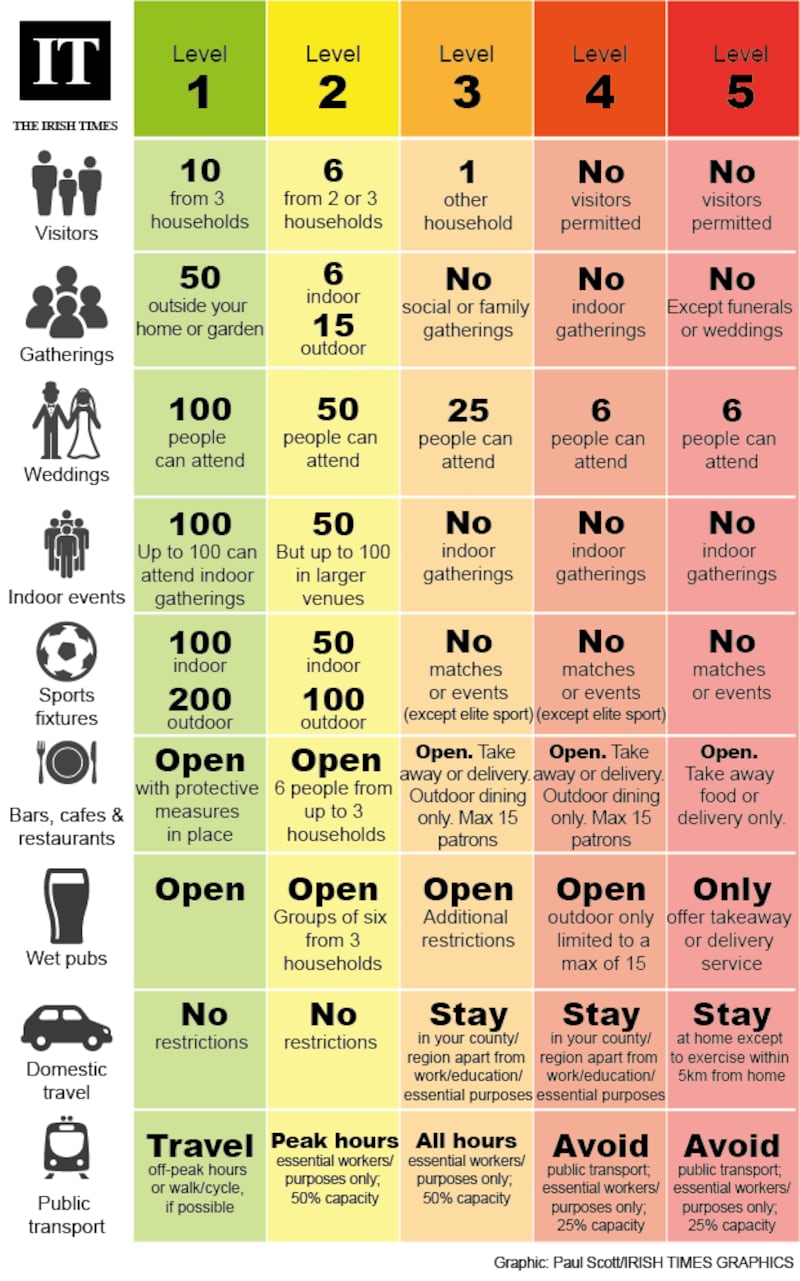Fears over more severe restrictions for other cities are growing tonight after the Government imposed Level 3 restrictions on colleges, which will see most tuition move online to reduce students’ movements, to try and curb the rise in Covid-19 cases.
Garda checkpoints are being rolled out in Co Donegal tonight ahead of the imposition of Level 3 restrictions at midnight and people have been urged to avoid all unnecessary travel across the Border between Ireland and Northern Ireland to reduce the spread of the virus.
Taoiseach Micheál Martin warned on Friday that other cities, in particular, Cork, Limerick, Galway and Waterford, could have additional restrictions imposed if cases continue to rise.
Hospital Report
In the Republic, 326 additional cases of Covid-19 were confirmed on Friday, while in Northern Ireland 273 new cases were recorded. No new deaths due to the virus in either jurisdiction were reported. The number people in hospital due to Covid-19 rose above 100 on Friday.
Acting chief medical officer Dr Ronan Glynn and his Northern Ireland counterpart, Dr Michael McBride, also made a specific appeal to teenagers and people in their 20s and 30s in Donegal and Derry to reduce their social contacts.

Donegal’s 14-day incidence rate is now higher than Dublin’s, with 148.2 positive cases per 100,000 population, whereas Dublin has recorded 144.5 positive cases per 100,000.
In neighbouring Derry and Strabane council area, the rate in the last seven days is 141.4 positive cases per 100,000 population - the highest in Northern Ireland.
Mr Martin said the National Public Health Emergency Team (NPHET) would advise the Government “in terms of any restrictions that may have to come in for other areas.”
He said the virus thrived in areas of high population density.
‘Very concerned’
“First of all we have an opportunity to avoid those areas going to Level 3 at all if we adhere to the public health guidance – reduce congregations, reduce the number of social contacts and wear masks in shops and on public transport.”
“NPHET may advise in terms of particularly localised restrictions though, to date, it has been on a county by county basis.
“Suffice to say right now they [NPHET] are very concerned. I was speaking to the Chief Medical Officer over the week and in places like Cork city cases have been going up in a straight line in the past two weeks.
“That is a worry – between 20 and 30 cases a day. That is worrying. Likewise in other city areas.”
On Friday night Dr Glynn, asked people everywhere but “particularly in Donegal and Dublin to pay special attention to the public health advice.”
“Because while there is every chance that other areas will have to move to Level 3, there is nothing inevitable about it. We have seen previously how people working together can turn the tide on this virus and bring increasing trajectories back under control.”
Hospital cases
The number of confirmed cases of Covid-19 in hospital has gone above 100 for the first time since early June. There were 102 confirmed virus patients in hospital on Thursday night, including 12 admissions in the previous 24 hours, according to the latest operational report from the Health Service Executive.
This represents a substantial increase on the 88 confirmed cases recorded the previous evening.
A further 114 suspected cases of the disease are also being treated in hospitals.
The Mater hospital, with 20 patients, Beaumont Hospital with 16 and St James's Hospital with 12 have the highest number of confirmed cases currently being treated, according to the report.
The number of patients in ICU decreased from 17 to 16 last evening. The Mater, Portlaoise and Wexford hospital have no free critical care beds at present, though across the system there are 45 critical care beds available.
Meanwhile, the latest epidemiological data confirms that Donegal has overtaken Dublin as the county with the highest incidence of the virus in the Republic.
As of Thursday, Donegal had a 14-day incidence of 148.2 per 100,000 people, compared to 144.5 for Dublin, the report from the Health Protection Surveillance Centre shows.
The incidence in Louth was 107.8 and in Waterford, 86.9.
The incidence in the worst-affected area of Dublin, the north-west, increased from 200.3 to 207.1
Compared to the previous day, the incidence in Donegal grew 21 per cent per cent, that in Dublin and Louth increased only slightly while in Waterford it fell.
Between Wednesday and Thursday, incidence rates rose in 11 countries, fell in another 11 counties and were unchanged in four others. Within Dublin, rates rose slightly in all regions except Dublin South-East.
This appears to show the appeals by public health officials for people to limit contacts and follow guidance is working.






